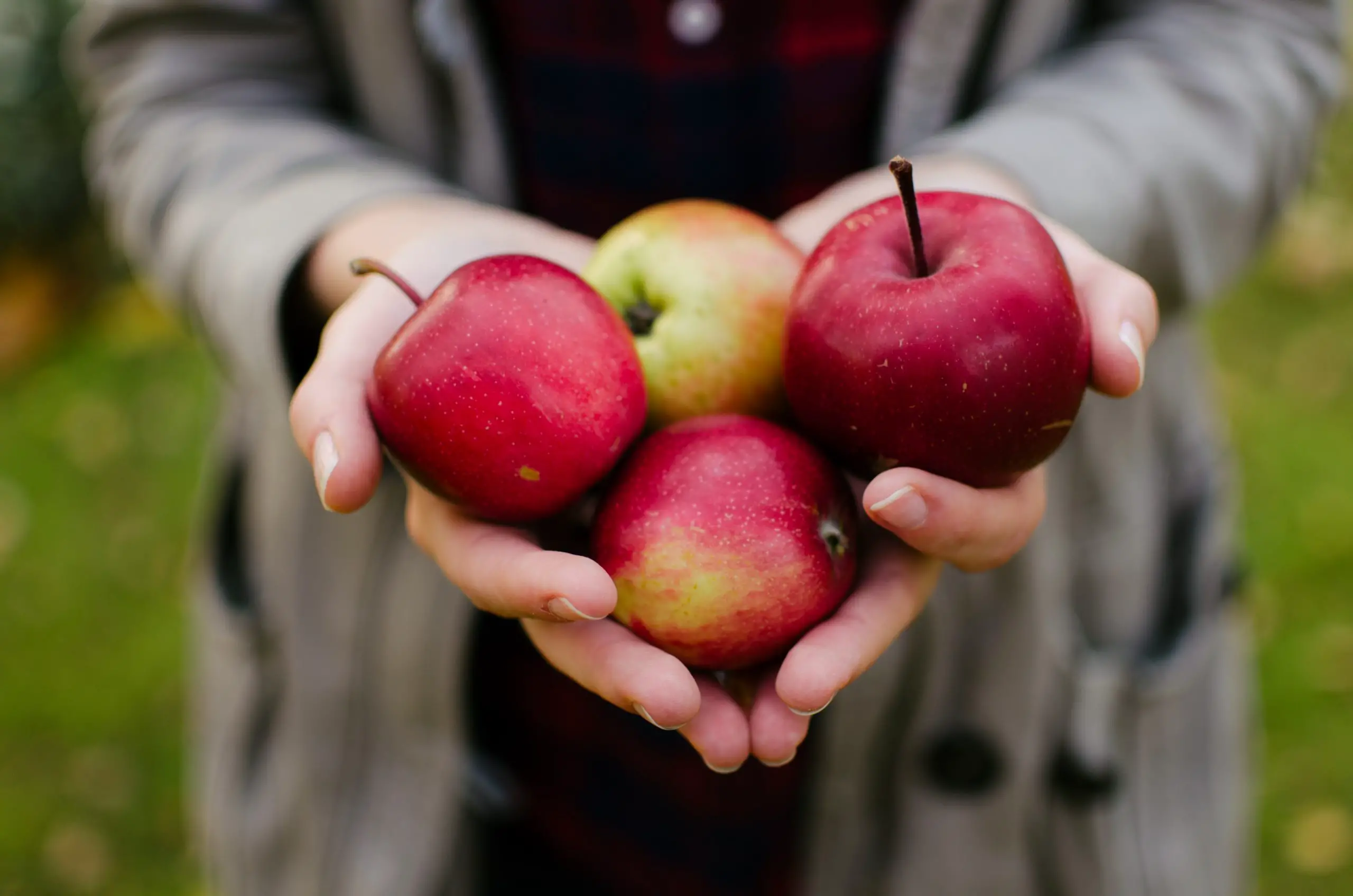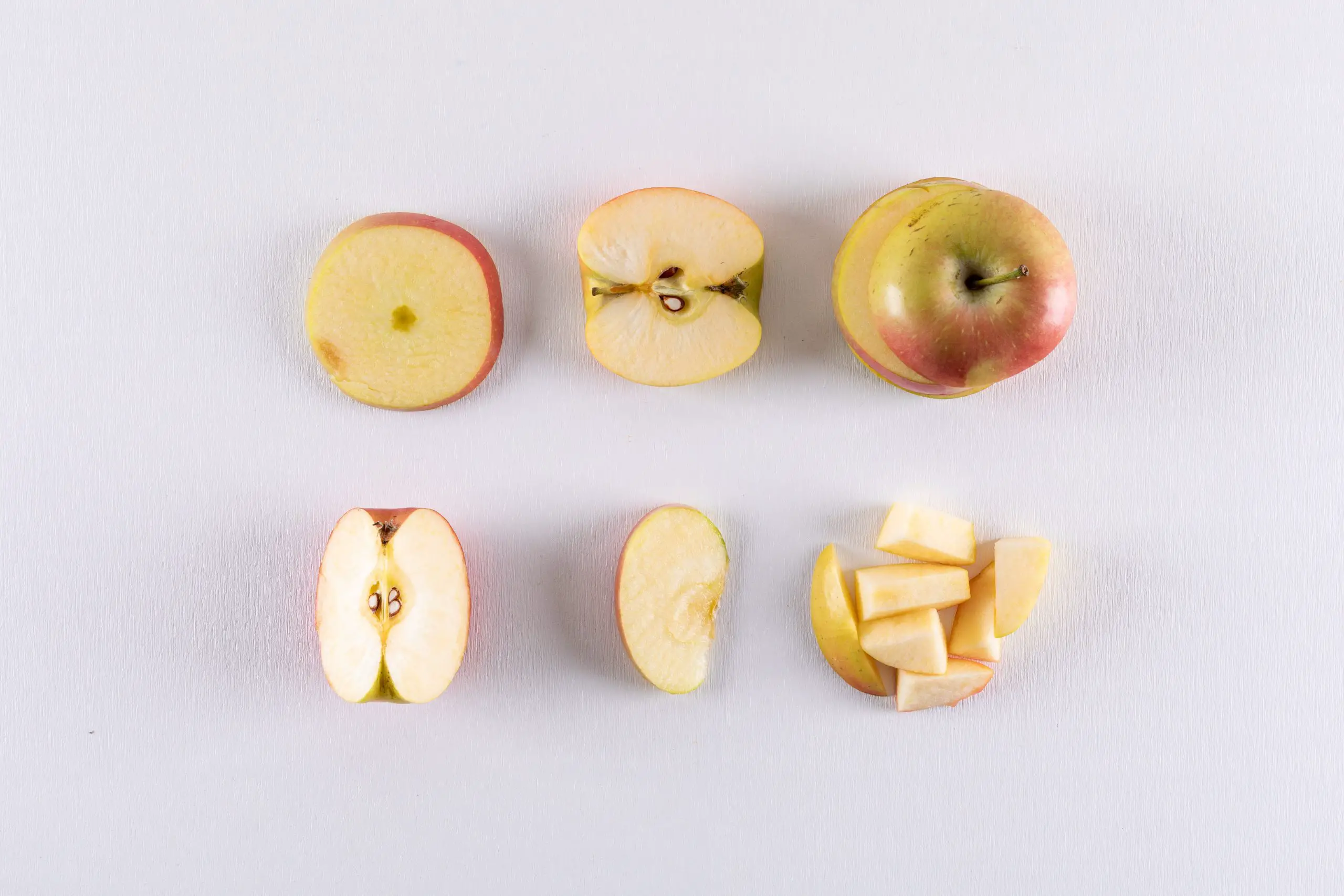Using frozen apples is a convenient way to preserve fresh fruit. You can keep them for up to 12 months in the freezer. You can thaw them at room temperature, in the fridge, or straight from the freezer. In the following paragraphs, you’ll learn how to prepare apples for freezing and use them in recipes.

Apples should be peeled, cored, and then cut into slices about half a centimeter thick. Slices should be placed in a big bowl with lemon juice spritzed. Toss the pieces collectively to distribute the lemon juice evenly. Slices should be placed in a food bag after being opened and frozen till solid.
How to Freeze Apples?
One of the many delights of the fall season is a trip to an apple orchard and hauling home a ton of fresh fruit. You are left wondering what to do with all that produce, much as when you collected peaches, strawberries, and blueberries earlier in the summer.
One method of preserving apples is to freeze the fruit if you want to bake with fresh apples in the upcoming months, such as in apple pies, bread, and cakes. Here are three methods for effectively freezing apples.
Freezing Whole Apples
There aren’t many good reasons to freeze an apple whole; once thawed, the texture won’t be crisp and juicy, and it won’t be easy to slice or dice for baking. However, if you are adamant about freezing whole apples, follow these steps:
The apples should be carefully cleaned and dried. Freeze them whole and unpeeled on a baking sheet. Transfer the apples to freezer bags after they have frozen. Before freezing them, please don’t put them in the bag; otherwise, you’ll have a huge clump of frozen apples.
Freezing Apple Slices
The technique of choice for freezing apples is this one. Apples should be washed, peeled, cored, and sliced into your desired size. (It is best to keep the pieces rather large; the smaller cuts might get too mushy during the thawing process.)
Once sliced, dip the apples in a water bowl with a little lemon juice (about a tablespoon per gallon) to prevent browning.
Place the apple pieces on a baking sheet, keeping them apart, and completely freeze them. This step keeps the pieces from sticking together, and you will be able to pull out the amounts you need later. Once frozen, transfer apples to freezer bags, seal and label the bag with the measurement and freezer date. You can freeze apples for six months.
Freezing Apple Pie Filling
Apples should be peeled, cored, and sliced to the size specified in the recipe for apple pie. Then, season and sweeten using the recommended amounts of sugar and spices. Try this brilliant freezing technique for a quick hit of pie at any moment.
The pie filling is prepared, poured into a pie plate coated with aluminum foil, and then frozen. Take the filling out of the foil when it has frozen, put it in a freezer storage bag, and keep it there until you’re ready to bake a pie.
Pour the frozen filling into a prepared pie crust when it’s time for pie, and bake. Using frozen apples may need you to bake your pie for a little while longer, but it won’t take much longer than baking a frozen pie from the grocery store.
Storing Frozen Apples
Storing frozen apples is a great way to preserve the nutrients and freshness of your fruit for a longer period. However, you must know some important tips to make the process smoother. First, you should peel your apples to reduce the risk of browning. Also, peeling will help you avoid bruises, which are common after the fruit has been frozen.
Another option is to freeze the fruit in airtight containers. A good airtight container will keep the apples fresh for three to six months. Using them within this period is best for the best flavor. But if you don’t plan to use them for that long, you can store them for up to one year.
When you freeze your apples, it is best to avoid storing whole ones. Whole apples will not have the same flavor when thawed, and they are difficult to slice for cooking. You should wash and dry the whole apples thoroughly.
After freezing, you should transfer them to freezer bags, which will help them thaw out more quickly. Remember to transfer frozen apples to freezer bags rather than placing them on the baking sheet. This will prevent them from forming a giant clump in the freezer.
Before freezing apples, you should cut them into slices or chunks. Then, you should remove the outer skin.
After peeling, core and slicing, you should dip them in a lemon-water solution to prevent browning during freezing. After freezing, you should put the frozen apple slices in a sealable freezer bag, which can remove air.
Can you Freeze Apples with the Skin on?
If you don’t mind using peeled apples in your baking (think baked apples) or if you enjoy them in your apple crisp, you don’t have to peel your apples. I advise peeling them if you plan to use them for smoothies or slushies.
How Long do Frozen Apples Last?
Without significantly compromising their flavor, frozen apples can be kept in the freezer for up to six months. Theoretically, they can be kept for up to a year, but I like to err on caution.
I believe the flavor is finest if you utilize them within 3 to 6 months if you’ll be using them in a festive dish.
How to Use Frozen Apples?
When thawed, frozen apples don’t defrost like fresh ones; thus, cooking is the best option.
Here are some suggestions for how to use them:
- Fruit smoothie
- Baked Apples (my preferred method for making this ahead of time is to freeze apples!)
- Applesauce in the Instant Pot (or Slow Cooker Applesauce)
- Low-carb Apple Crisp
- Add some homemade apple butter to any smoothie recipe.
I hope this guide may be useful the next time you have an excess of apples on hand, whichever you choose to use.
Can you Freeze Stewed Apples?
Yes. You may freeze the cooked apples after stewing a large batch of apples for uses like pie filling.
Before vacuum sealing the apples for freezing, you can compress and arrange them more tightly because they become soft when stewed. If you do this, they will be flatter and more tightly packed in the freezer.
How to Freeze Apples that are Caramelized?
You wanted to reserve that caramel apple treat for a rainy day because you couldn’t finish it. Here is an easy method for freezing caramelized apples that you may already have in your kitchen.
Step 1
Apples with sticks or forks should be removed. Forks or pointed objects should not be placed inside the apples because there is no room for them.
Remove them to prevent damaging your freezer bag or taking up too much room in your freezer.
Step 2
One apple at a time should be placed in a freezer storage bag.
Since they are sticky, it is best to put one apple at a time in a bag to keep them from sticking together. The apples benefit from a better vacuum seal as a result of this.
Step 3
Before you close the bags, get rid of as much air as you can. By doing this, the freezer burn of the apple and the caramel surrounding it will be avoided, preserving the consistency of the caramel.
Can I Freeze Apples without Cooking Them?
Apples can indeed be frozen without being cooked.
Apples don’t need to be cooked before freezing. To avoid this, you can blanch the apples, especially sliced apple pieces, to stop them from browning. Food is blanched by temporarily submerging it in hot water, followed by an ice bath.
Reference: Effects of freezing, freeze drying and convective drying on in vitro gastric digestion of apples
How to Store Cooking Apples in Freezer?
Like all of the other foods we’ve talked about thus far, cooked apples can be frozen.
- As desired, cook your apples.
- Leave them at room temperature to cool down. Follow these steps to freeze your cooked apples properly:
The FDA warns against leaving cooked food out at room temperature for more than two hours since this will encourage the food’s natural germs to multiply to dangerously high levels, raising the risk of food poisoning. - Leave some space between the cooked apples when you place them on a baking sheet. Make sure they stay away from one another.
- You should freeze them.
- They should be firm to the touch after 15 minutes in the freezer. The risk of freeze burn may grow if you keep the apples on the baking sheet without a bag for more than an hour.
Although freeze burn is not harmful to your health, it will alter the flavor of your apples and make them tasteless. - Put them back in the freezer after placing them in Ziploc bags, airtight containers, or vacuumed bags.
- Spices should not be added to your recipes before freezing because some spices lose flavor when frozen.
- Therefore, it is best to add the spices to the cooked apples just before baking or as needed.
Tips for Freezing Cooked Apples
These additional suggestions will help you have the finest freezing experience now that you are familiar with freezing cooked apples.
- Add a splash of lemon.
The apples’ flavor is unaffected when thawed, which helps prevent browning. It only takes a tiny splash. - Spices and apples should be combined.
If you’re going for frozen apple pie filling, Consider adding your spice mix to your cooked apples for even fewer worries in the future. The spices lose little to no potency, and the fruits retain their nutritional benefits. Do not forget to include the ingredients on your label. - Also, freeze your crumble.
You can freeze your crumble and still have a crunchy top crust if you are storing your cooked apples to use them in an apple crumble pie. Simply store your crumble in a different freezer bag from your apples.
Conclusion
So, can apples be frozen? Yes. When apples are in season, freezing them is a terrific method to preserve some of the best fruit and save money. Whatever your motivation or need, freezing apples can typically be accomplished with very little planning and work.

